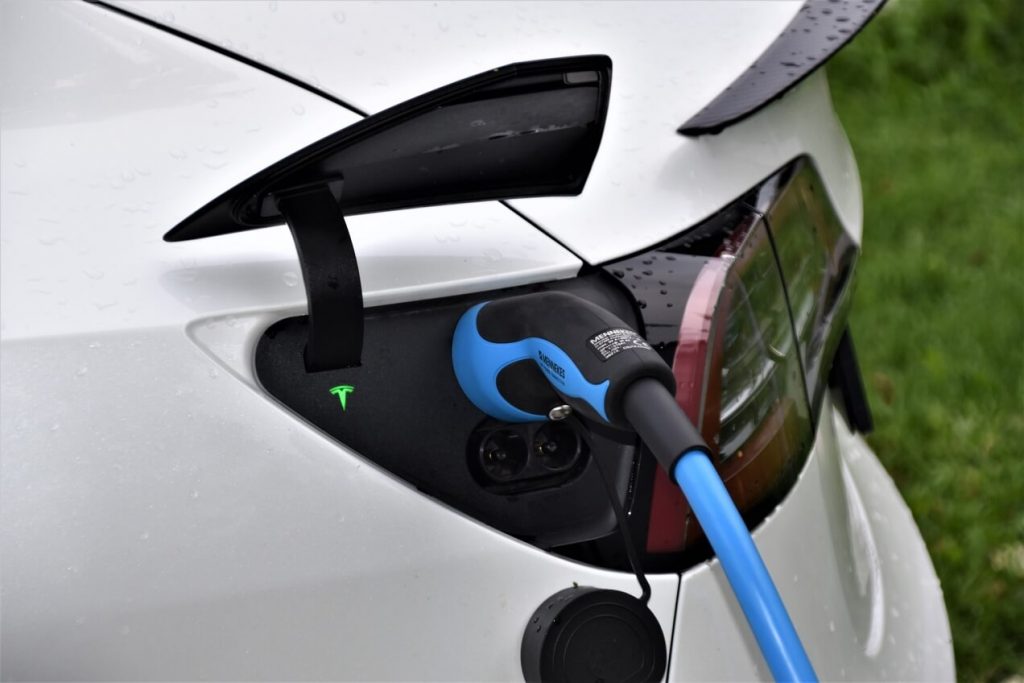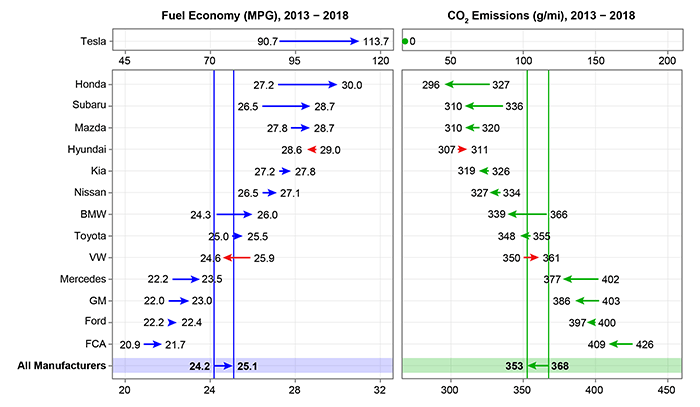Innovate or die
Technological innovation in the automobile industry has led to a wide array of technology available to manufacturers to achieve CO2 emissions, fuel economy, and performance goals. Engine technologies such as turbocharged engines and gasoline direct injection allow for more efficient engine design and operation. Cylinder deactivation allows for use of only a portion of the engine when less power is needed, while stop/start systems can turn off the engine entirely at idle to save fuel. Hybrid vehicles use a larger battery to recapture braking energy and provide power when necessary, allowing for a smaller, more efficiently operated engine. Transmissions that have more gear ratios, or speeds, allow the engine to more frequently operate near peak efficiency.
Lately, there has been an increased focus on reducing the emissions detrimental to human health rather than just CO2. A knock-on effect of the technology designed to reduce CO and NOx emissions is that more fuel can be burnt, which means more CO2 is produced. It’s a bit of a Catch 22 scenario right now, although carmakers are working on balancing these better.
As a guide, any non-hybrid petrol or diesel car with a CO2 emission figure of under 100 grams per kilometre of driving (typically presented as 100 g/km) should be considered pretty green compared with most cars. Plug-in hybrids should be able to achieve less than half that figure with ‘self-charging’ hybrids sitting somewhere in between. There is a big caveat with plug-in hybrids, however…
Plug-in hybrids only emit far lower emissions than conventional petrol or diesel models if you regularly charge them (most have a claimed electric range of around 50 kms, potentially less on real roads). Fail to charge regularly and plug-in hybrids are likely to be bad for the environment, as once battery charge is depleted they rely on their petrol or diesel engine and also have to carry the weight of the electric motor and batteries around – with extra weight typically resulting in worse fuel consumption and greater emissions.
Yes, you can expect a small boost from the electric motor in a plug-in hybrid if you’re driving around town and the batteries are flat, as braking adds back a little charge, but drive like this and a plug-in hybrid is likely to be pretty inefficient.
Furthermore, plug-in hybrids require more materials to be mined in the first place – not only do they have a petrol or diesel engine, they also have an electric motor and batteries. As a result, there are big question marks over the environmental credentials of plug-in hybrids. The logic behind these models is that they can run with zero emissions around town for short distances – if you charge them regularly – but are also capable of a long trip without having to recharge regularly.
As many standard electric cars now offer a claimed range of more than 300 kilometres, though, these make sense even for drivers who need to do the occasional long journey. And if all your driving is motorway trips of more than 300 kms, then you’re likely to be better off going for a petrol or diesel car than a plug-in hybrid, as you wouldn’t be getting much economy benefit from a plug-in hybrid at higher speeds.
Fudging the figures
When it comes to being environmentally friendly, cars with lower the emissions figures and higher fuel economy are better. Provided a car is properly looked after, its emissions and economy figures shouldn’t get worse as they get older. In fact, in the past it took cars several thousand miles before they were producing maximum power and running with the greatest efficiency.
In saying that, due to official tests being largely conducted in laboratories, the actual economy and emission figures cars are sold with tend to be more optimistic than what you can expect to achieve in the real world. Be aware that over recent years two different types of economy and emissions tests have been used.
For cars registered before September 2018, the ‘NEDC’ economy test was used. This test format didn’t reflect real traffic and driving styles and so claimed fuel economy figures are typically much higher than most drivers are likely to achieve in everyday driving. As a result, from September 2018 onwards, a new more realistic ‘WLTP’ test was phased in for new cars.
This should be much more representative of real roads and traffic, and so you should be able to get closer to this figure with normal driving. All new cars registered from September 2019 onwards should have fuel economy and emissions figures calculated using the more realistic WLTP test. Bearing this in mind, a car that achieves 50mpg on the newer WLTP test is likely to be more economical in everyday driving than one that has a 50mpg figure recorded on the old NEDC test.
For the love of your preferred deity, service your car people!
Okay, I’m checking my white, middle aged male, automotive business owner privilege in here. Servicing your car can be a budget breaker for some and I get that. However, fixing your car when it breaks is worse. Soapbox moment over.
Maintenance has a huge bearing on whether or not a used car is as environmentally friendly as a new one. For starters a car’s emissions are directly related to how much fuel is burned, so an engine which isn’t running properly may emit more pollution than one that is.
Exhaust systems are vital in reducing vehicle emissions. Items such as catalytic converters, particulate filters and exhaust gas recirculation valves all have finite lifespans and will likely need love to insure a used car is keeping its emissions under control. Like all love affairs they have their price, and in older cars with lower values they can be neglected by drivers as replacement parts can be pricey.
When a car is neglected this shortens its useful lifespan. Keep a car well fed and watered and it will last significantly longer than one which isn’t. Since building new cars requires an awful lot of energy, it’s good for the environment to keep older cars running rather than simply building more and more new ones. Scrapping cars takes its toll on the environment as well, especially if they are not disposed of properly.
Is that an elephant I see in the corner?
Obviously, there is a reliability factor with older vehicles that can be very off putting when you know nothing about cars. You have to deal with a mechanic and you have to trust they know what they are doing and have you and your old car’s best interests at heart. A good Technician (formerly known as a mechanic) keeps up to date with training constantly, is networked with other likeminded individuals and asks for help when needed. There is an ever-growing global community of automotive diagnosticians who share their knowledge freely and understand that the industry as a whole is better off for it.
From a customer service point of view, good businesses will test first and replace second, look at your whole car and give you a complete picture. They will give you an up-front quote and will inform you of options to help spread the cost of maintenance and repairs over time. When it comes to complex diagnostic work that has to take into account different systems in a vehicle, they will let you know what evidence they have for the recommendations they have and most distressingly to car owners, tell you that a guaranteed fix may not come from the next step. And they will let you know when you need to report back as part of the testing process and follow up with you to ensure things are going ok.
So, the answer to my conundrum?
Remember way back when I said this article was about my personal journey to environmental inner peace as a bona fide card carrying car guy? Well, like the convoluted pathway that brought you to here (thanks for bearing with me) it’s another pathway again.
My choice is about combining the old, with the not so old. I am embarking on ‘project conundrum’, which is converting a 21 year old Mazda MX5 to be powered by a 2014 model Honda engine. It ticks my boxes for a sporty drive, with more power, recycling some used parts, better fuel economy and a love of cars.
This clearly is not a choice most can make, but I hope that exploring my rationale for not wanting to buy a new electric car has shown you some ways to look at the choices you make.








